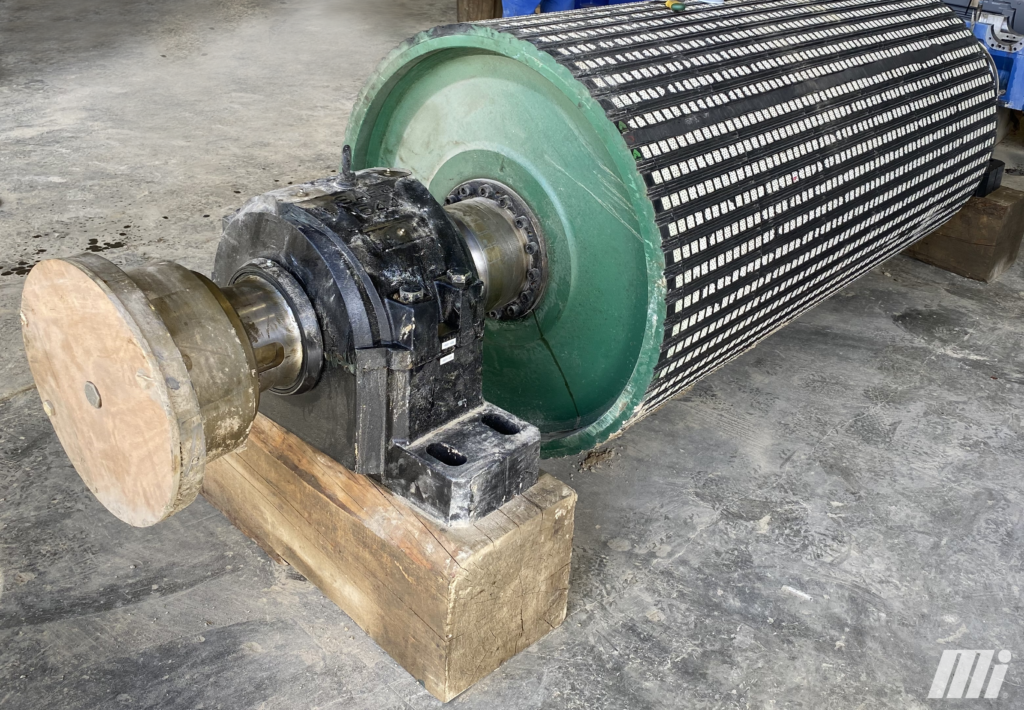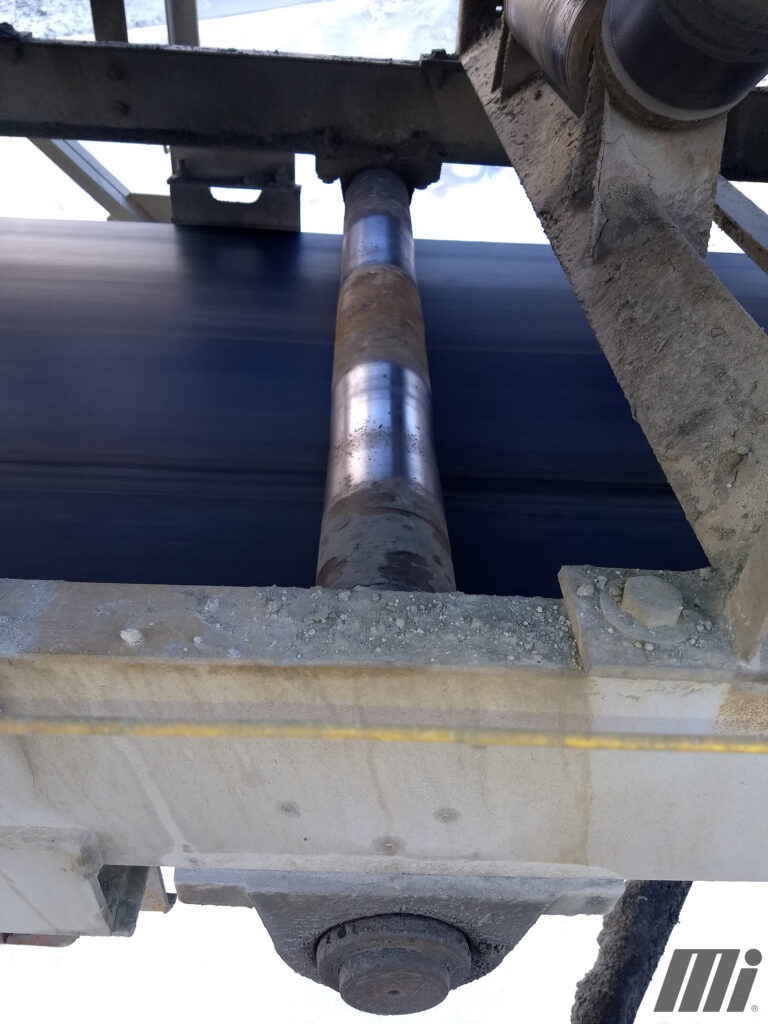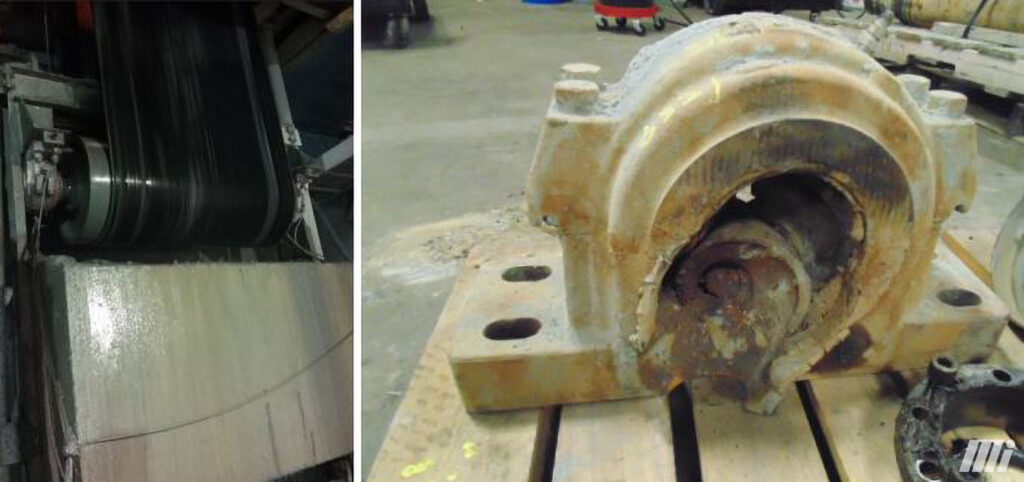
Do you have fugitive materials on the loose?
Defend your conveyor profitability.
January 4, 2023 | By Wyatt Phillips
 Photo: Motion.
Photo: Motion. 
Photo: Motion.
If you have conveyor carrying materials, be assured that some gets lost. Collectively, these materials on the loose that end up where they shouldn’t, are referred to as fugitive materials. This material loss can occur in many forms, including leakage, spillage, or carryback, which is material that adheres to the belting after the discharge point and is deposited along the conveyor return. Fugitive materials can be coarse, heavy, or even light airborne particles that escape the conveyor and settle as abrasive or dangerous dust. However, why should we care about fugitive materials so much?
Some industry estimates place the loss from such escapees into billions of dollars, annually. If you have conveyors, the sobering question you might ask is, “What is my share of those losses, and what can I do?”
First, let’s consider where and how these losses occur. When the material that costs so much to produce ends up on the ground or in some other unrecoverable area, it directly affects your bottom line.
Additionally, fugitive materials have serious consequences that may not be as obvious. Lost materials can degrade the reliability of your conveyor components (e.g., bearings and rollers) and cause excessive wear to the structure. Fugitive materials can also cause workplace hazards. This results in unplanned downtime, constant cleaning work, and even regulatory scrutiny and action.
Take control with proven modern solutions
Can we eliminate the fugitive material problem? No, but with some new practical improvements, we can mitigate it and make life and profits better for your plant. Let’s focus on improving a few key areas that can offer the greatest return on investment. In recent years, leading manufacturers have engineered innovative solutions that don’t require significant conveyor alteration. Unfortunately, we seldom see these innovations on even new OEM conveyors in some industry segments. Therefore, you can significantly improve your plant’s fugitive material problem with these solutions.

Photo: Motion.
Tools to stop fugitive materials
SKIRTINGS
The most obvious solution to the fugitive material problem is to contain it. Keep those fugitive materials where they belong. A belt skirting system can drastically reduce spillage and dust; the skirting fastens to the conveyor near the loading points or load zone area. Skirting is designed to make light contact near the top edges of the conveyor belt, forming a seal. Conveyor belt skirting isn’t new, but the advancements are worth considering. Choose a system that is simple to install and allows for skirting adjustment and replacement. There are many skirting choices, including styrene-butadiene rubber (SBR), natural gum, and even high-end flexible urethane. In addition, many shapes, including dual lip, create a larger contact surface for the skirting to make a strong seal contact with the belt.
BELT CLEANERS
Without a primary belt cleaning solution, fugitive materials will stick to return rolls and build up below the conveyor, creating problems such as belt tracking issues. Belt scrapers remove bulk material product carryback and prevent it from being deposited at points along the conveyor return side of the belt. These primary belt cleaners, sometimes called pre-cleaners, are mounted directly against the head pulley below the typical trajectory of the material.
A scraper has two main components: a blade that contacts the belt and a mechanism that keeps it in the proper contact position. The blades are installed at an angle that peels away anything stuck to the belt surface. Many commonly available cleaners use blades made of polyurethane—effective due to its flexible, chemical-resistant nature—allowing the blade to endure harsh conditions.
The blades are available in different hardness levels measured in durometer, depending on the application requirements. If you are conveying slurry material, you will want a blade that acts as more of a wiper that essentially squeegees it off the belt. Wiper blades generally have a softer durometer (70A), allowing for flexibility as they perform like a squeegee pushing liquid away.
A secondary cleaner is installed on the return side of the belt after the point where the belt leaves the discharge pulley. Secondary cleaners are very effective at removing fines and significantly increase cleaning efficiency. A two-scraper arrangement with primary and secondary cleaners effectively removes nearly all material.
OPTIMIZED PULLEYS
Installing a ceramic lagged conveyor pulley is one standard improvement to reduce carryback on your belt. Ceramic has many advantages, including shedding water and dirt faster than conventional lagging. However, a key reason for upgrading to a ceramic lagged pulley is to vastly improve traction on the belt, reducing slippage. This upgrade is vital because a slipping belt causes tracking issues and excessive material buildup in the loading zones, resulting in fugitive materials falling off the sides of the belt. But ceramic lagging may not be enough to control the situation.
In some applications, you can install a wing pulley. These reduce the risk of belt damage from lumps of material trapped between the belt and the pulley surface. They are effective at self-cleaning since the only surface where material can accumulate is at the edge of the wings, and the rotation of the pulley slings the material away.
The original wing pulleys looked like the paddle wheel on a steamboat, but their designs have improved in the last decade. Look for one with a spiral or herringbone twist to the wings, which performs better for belt tracking and repelling any incoming fugitive materials.

Photo: Motion.
Solutions to uncontrollable fugitive materials
DISC RETURN ROLLERS
If any material makes it through your fugitive material defenses by wind or control system failure, it can accumulate over time. Often, this buildup is located on the return side of your conveyor. It is especially problematic in climates where wet and cold weather makes the fugitive material viscous, bonding to surfaces and then hardening. Like sticky dough on a rolling pin, this material clings to the pulleys, belts, and rollers after the cleaner. The accumulation can cause significant problems with belt tracking and premature failures.
The best option is to replace your standard flat face rollers with disc return rollers, which use rubber or urethane discs spaced along the shaft. By reducing the surface area and belt contact, the discs drastically minimize material buildup on the roller. Rubber is a standard selection for disc return rollers; however, polyurethane is a top choice for material due to its natural resistance to adhesion and abrasion. Urethane rollers are also available in spiral form, resulting in a point of contact constantly moving on the conveyor belt surface, creating a smooth cleaning action.
BEARING UPGRADES
When material escapes the conveyor, it will accumulate anywhere it can settle, covering your conveyor components and equipment. Eventually, you have pulley bearing, idler and gearbox failures. All your moving parts on the conveyors have bearings, which must stay clean to run. In the mining industry, these pulley shafts glowed red hot as they bored their way through what was left of a failed bearing as it melted, and the housing that once supported it was chewed away. Often, all this bearing carnage starts with dust—tiny particles of fugitive material that find their way through the bearing seal. A contaminated bearing is doomed, and bearing failures are dangerous. Entire conveyors and plants have burned down from bearing failures on conveyor pulleys.
Idlers, although using much smaller bearings than pulleys, can cause great damage when bearings fail. Failed idlers can seize, and the belt will continue to scrape across the stationary idler, drawing more motor power until the belt grinds its way through the idler. The resulting idler damage produces sharp edges that will slice up the belt, creating another expensive and dangerous failure situation.
Many kinds of bearing seal systems are available and choosing the right one could be the solution to preventing premature bearing, pulley, idler, and belt failures. One significant improvement is installing a quality taconite-duty seal. These robust seals were developed to seal out one of the most notorious fugitive materials in industry history: taconite, an abrasive iron-bearing mineral. These seals comprise two rings (one stationary and one rotating), forming a very narrow labyrinth between the rings.
A v-ring seal on the rotating ring creates a seal against the labyrinth ring, which remains stationary. The v-ring seal guards against contaminants entering the bearing housing and helps purge contamination and old grease when the seal is re-greased. Taconite seals constitute a significant improvement, but if you’re serious about keeping those fugitive materials out of your bearings, select the complete triple barrier solution. Barrier one is the taconite contact seal on the housing, barrier two is the housing cavity filled with grease, and barrier three is the new, factory-sealed for-life spherical roller bearing. These are now available and can be installed in your existing housings. With that barrier trio, fugitive materials must penetrate a highly advanced labyrinth seal, a layer of cavity grease (which can be purged) and another seal on the bearing itself.
Conveyors carry your profit
Many available options can mitigate the carryback of fugitive materials; these are just a few of the best. With the best bearing seals, a belt cleaner, upgraded pulleys, and disc return rollers all working together, you will make your conveyor more economical, safer, and more reliable.
Your conveyor carries your profits. Simple changes can significantly impact downtime, safety, and productivity gains. Even if an overhaul is not in the budget, keep in mind that preventing material loss, workplace injuries, unplanned downtime and extra cleaning will start paying back immediately. Rather than viewing these optimizations as one big project, pick an area of your conveyor that needs the most attention and begin there. Small changes over time yield massive results. Contact a local, qualified distributor representative/expert and ask them to show you some options and guide you through the selections that will control your fugitive material problem.
_______________________
Wyatt Phillips is Motion’s Prince George branch manager in British Columbia. A technical account representative for 10 years before his last three as branch manager, Phillips’ continued interest is reliability-focused solutions for customers in the mining, energy, and pulp sectors.
